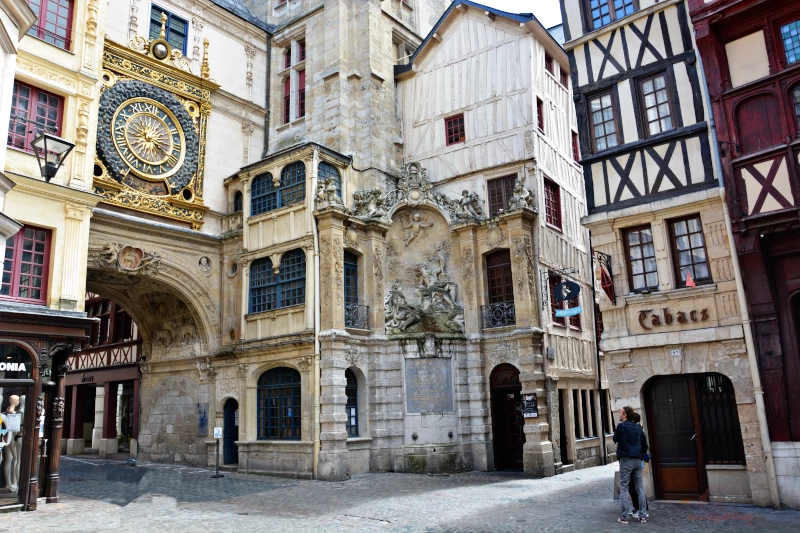
If you are traveling in the north of France, then make a stop in the port city of Rouen on the Seine. The beautiful old town with its many half-timbered houses, old churches and the huge cathedral Notre Dame of Rouen as well as a rich history and culture offer plenty of material for several days of visits.
[Contains *advertising]
Rouen on the Seine river – big city and yet cozy
Where is Rouen located?
The city of Rouen is the capital of Normandy and is located on the Seine River in northern France. About 70 to 80km separate Rouen from the Normandy coast and yet it is sea – port city – the Seine is navigable for sea ships with max. 260m length despite wide meanders to Rouen. From Paris it is about 110km in northwestern direction. About 70km west of Rouen is Le Havre on the Channel coast, where the Seine then flows in a wide funnel mouth into the English Channel.
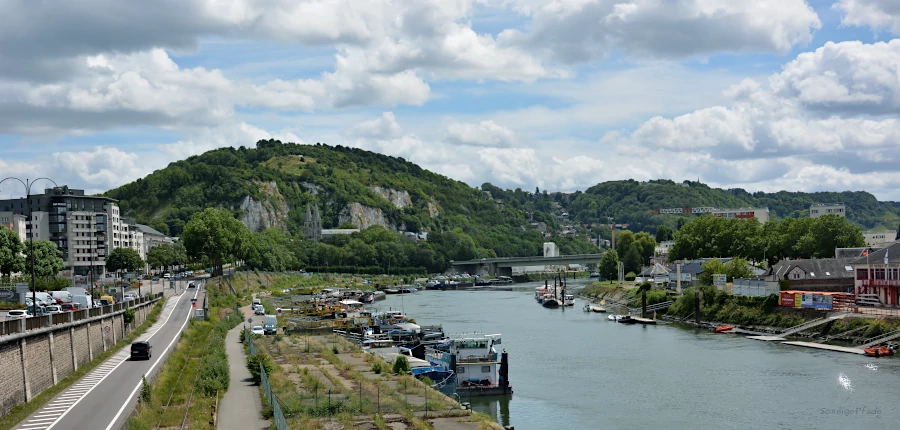
Rouen’s old town – characterized by half-timbered houses and Gothic churches
Rouen is a big city with about 112,000 inhabitants – and yet, at least in the old town center, quiet and downright cozy. The old town of Rouen is located north of the Seine and is still characterized by almost 2000 half-timbered houses in Norman style, some of which date back to the Middle Ages. This old town center is largely free of cars, which makes strolling in the narrow alleys and small streets pleasant and cozy. Only in the periphery already in the 19th century larger aisles for roads were cut and the two world wars contributed to the fact that also some modern buildings and streets can be found in the old town.
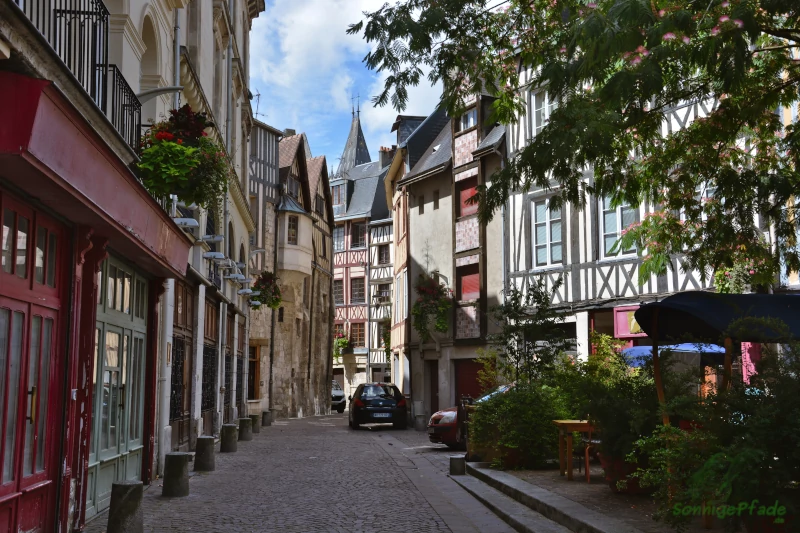
Rouen is famous for its churches. The French writer Victor Hugo is said to have spoken of Rouen as the „city of 100 steeples“. There are not quite that many, but about 30 church towers still characterize the „skyline“ of the old town of Rouen. Among them are those of Notre Dame Cathedral, one of which, at 151.5 meters high to the top, is the tallest church tower in all of France. Just the view of this steeply rising tower is impressive. I always have to think of the builders who erected this spire at dizzying heights at some point – with a fantastic view, to be sure, but on extremely narrow armor and quite a bit of wind around their noses….
Celebrity of French history – Joan of Arc, the Maid of Orleans
Of course, in Rouen you encounter a number of historically significant events. For centuries, the city was repeatedly at the center of the struggle for dominion between French kings and the English crown. The most enduring and well-known to visitors today is the story of Joan of Arc, the „Maid of Orleans,“ who fought against English domination in northern France, was captured in 1430 and imprisoned in Rouen. Here the trial against her took place and here she was publicly burned as a heretic on May 30, 1431 after a witch trial influenced by the English. Later, in 1456 her rehabilitation trial took place in the same building.
Since 2015, there is a multimedia exhibition „Historial Joan of Arc“ in the former bishop’s palace where the trials took place. There, the life story of Joan as well as the trial and rehabilitation are traced with scenic video – installations.
The „Joan of Arc Tower„, where the brave fighter was imprisoned and tortured, has since been opened for „escape games“. The tower le Donjon was the keep, i.e. fortified residential tower and is the last component of a castle from about 1200. In its vicinity, by the way, was the amphitheater at the time of the Romans.
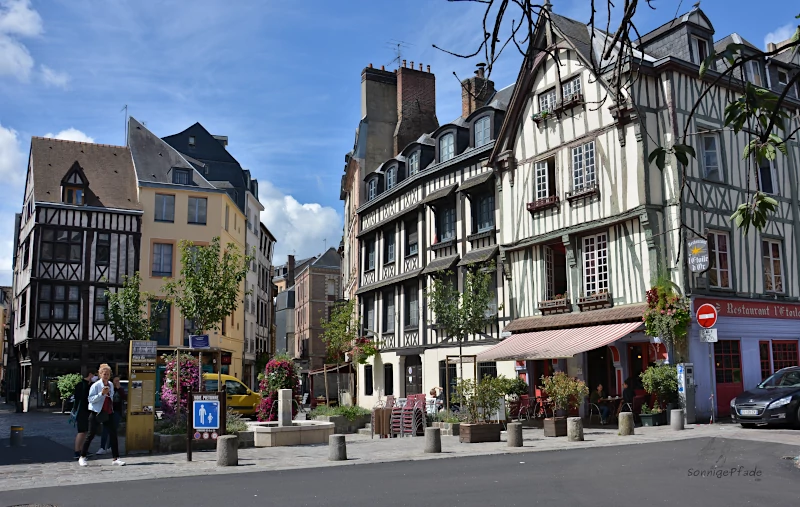
Cathedral Notre Dame of Rouen – impressive for centuries
Next to the Episcopal Palace stands the Cathedral Notre Dame of Rouen, which has been captivating people from near and far since the 13th century. Construction began in 1180 and the first cathedral was built by about 1235. Rouen Cathedral was the royal place and burial ground of the Norman dukes – the heart of Richard the Lionheart is also buried here.
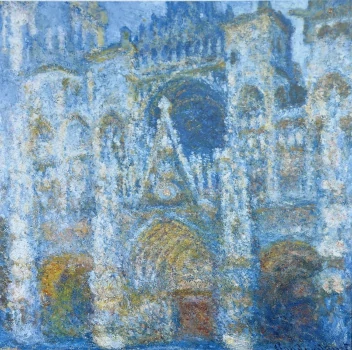
The cathedral was extended between 1370 and 1450 with, among other things, the famous west facade. Its fame increased mainly due to the participation of the French Impressionist Claude Monet, who painted this façade 33 times in changing light situations from an opposite building between 1892 and 1894. Only one of the paintings can be seen today in Rouen: In the Art Museum, Cathédrale de Rouen. Le Portail et la tour d’Albane. Temps gris by Claude Monet.
Of course, the construction of this huge cathedral cost a lot of money. Interesting is the story about the „butter tower“ – During Lent, butter was banned, and it was also not allowed to trade butter. Only the cathedral chapter had the privilege to sell butter for the fasting people and financed the construction of the tower with the profit. In the towers of the Cathedral Notre Dame of Rouen hang numerous bells and a 56-voice carillon, including the large bell „Jeanne d’Arc“ with almost 10 tons. All the bells have female names of celebrities. If you want to hear the bells, you should go to the cathedral square in time before church services – this ringing alone is impressive.
In the summer months from June to September, a „videomapping“ takes place on the façade every evening, during which the portal is illuminated in various colors á la Monet. This is definitely a spectacle worth seeing!
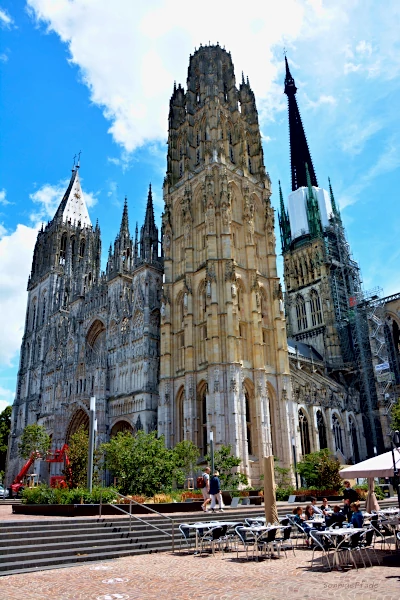
The Gros Horloge hour clock and Palace of Justice in Rouen
Opposite the cathedral on the same square is an old ornate merchant’s house from which Monet painted his facade views while standing at the window. Today it houses the Rouen tourist information office.
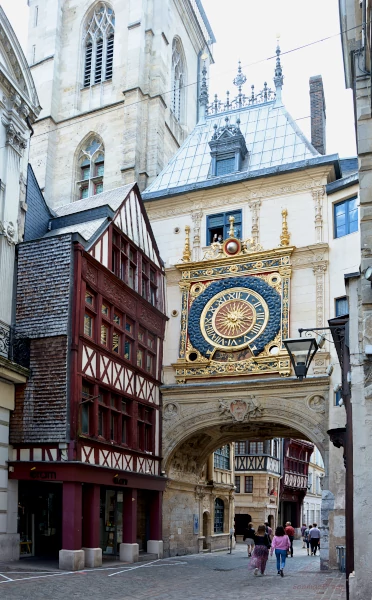
One of the streets leading into the square is Rue de Gros Horloge. This leads you to another famous building of Rouen – the clock tower with the hour clock Gros Horloge from the 16th century. The clock has, as was still common in those days, only one hand that shows the hours. This is decorated with a sheep, the Rouen coat of arms. Above the richly gilded dial is a dark silver ball in an opening. This illustrates the current phase of the moon. The Great Clock of Rouen immediately reminded me of the Apostle Clock from Prague’s Old Town Hall. And as luck would have it, in a shop window just nearby, both clocks were depicted on a poster next to each other. The clock building of the Gros Horloge of Rouen is a kind of gatehouse above the Rue de Gros Horloge and can be visited.
Also in the maze of alleys in the old town, you will probably come across the Rouen Palace of Justice at some point. This was built starting in 1509 and is the largest non-sacred Gothic building in Europe. The area of the old town around the palace seemed to me, however, a little more „modern“ with smaller department stores, which attracted more of a shopping audience. But a few steps further you are already immersed again in the narrow and pleasing half-timbered streets.
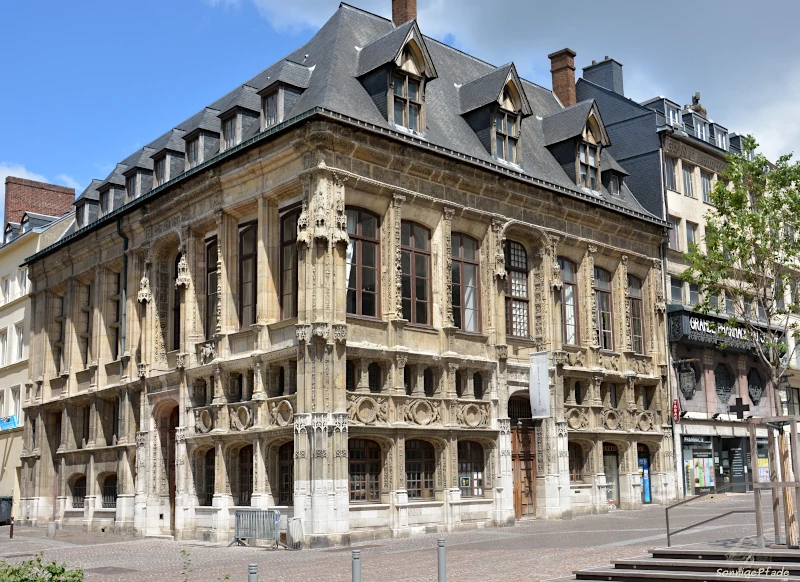
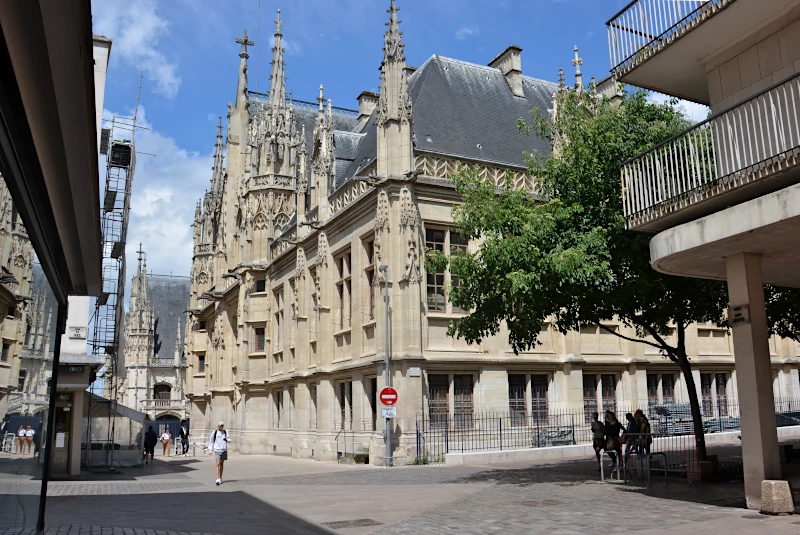
The old market of Rouen and the Eglise Jeanne d’Arc
At the eastern end of the large old town area is the Place de Vieux Marché, Rouen’s old marketplace. This is also surrounded by colorful half-timbered houses, many of which contain restaurants with outdoor seating and terraces. Among them is the oldest restaurant in France: La Couronne has been welcoming guests in the center of Rouen since 1345. Today it is a half-timbered gable decorated with flowers and flags in the middle of the southern front of the houses.
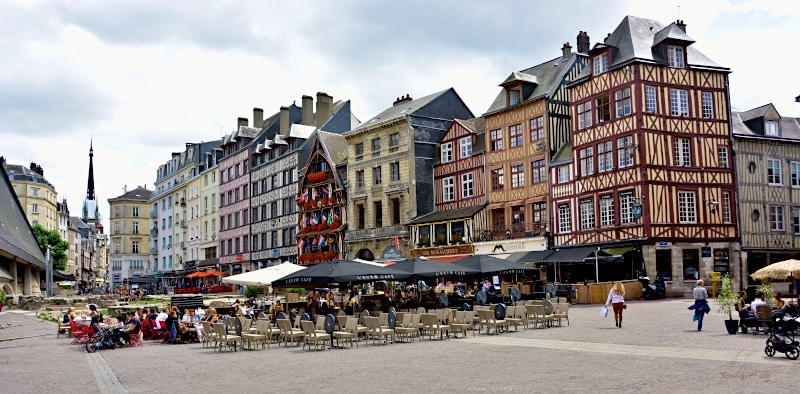
Many tourists visiting Rouen for the first time, however, are a little shocked by a large building in the middle of the Place de Vieux Marché – the Eglise Jeanne d’Arc. The modern church building was inaugurated in 1979 and stretches across the square in a rather dominant and perhaps style-breaking manner, with idiosyncratic architecture and dark roofing, as well as a facade that is not very colorful. After all, the church stands on the spot where Joan of Arc was burned in 1431 and commemorates the canonized French heroine.
The Church of Joan of Arc is interpreted in different ways. Some think they see in the soaring roof the symbolism of clouds of smoke over a funeral pyre. Others claim that the architect wanted to recall the Norman seafaring tradition of Rouen and the seafaring churches common in the region, and that the building represents a capsized ship on the high seas. I approached this church from the east on my first visit and my interpretation goes back to my spontaneous first impression: a scaly dragon with a long tail stretching across the square to the east.
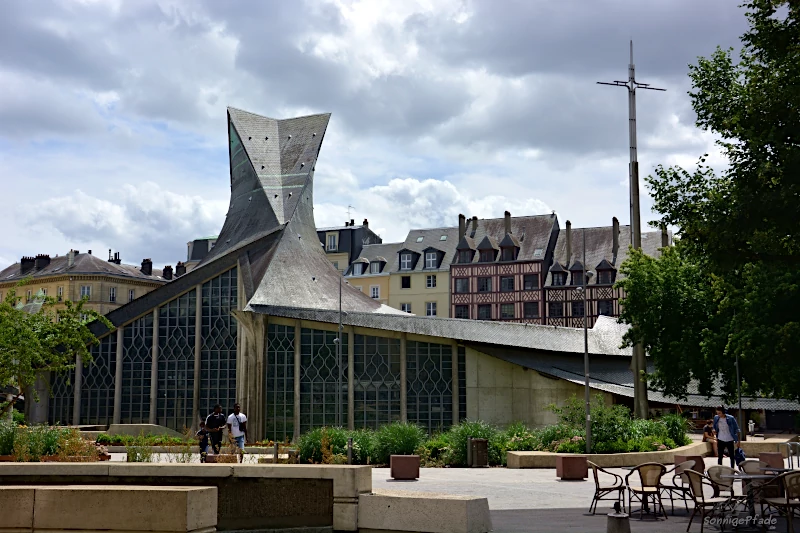
To the west, a small market hall in the same architectural style follows almost seamlessly. There, among other local products, you can buy the Norman cheese Neufchâtel, a brie in the shape of a heart. If you have the opportunity, you should first visit the interior of the Eglise Jeanne d’Arc. You will be able to admire the bright stained glass windows of the old church of St. Vincent, destroyed in 1944, which were installed in the Jeanne d’Arc. These windows from the 16th century depict biblical scenes and the representation of saints – myths.
On the eastern edge of the Place de Vieux Marché there is also another showpiece that is definitely worth seeing: the Hôtel du Bourgtheroulde was built in 1486-1531 as ornate Renaissance architecture and since 2010 has housed a luxury hotel with a fine restaurant and spa*.
Around the Place de Vieux Marché there are many small streets and alleys that invite you to store. For there are boutiques and smaller department stores, as well as some stores with a long history, such as the Fromagerie Olivier – also a source of the Norman cheese Neufchâtel.
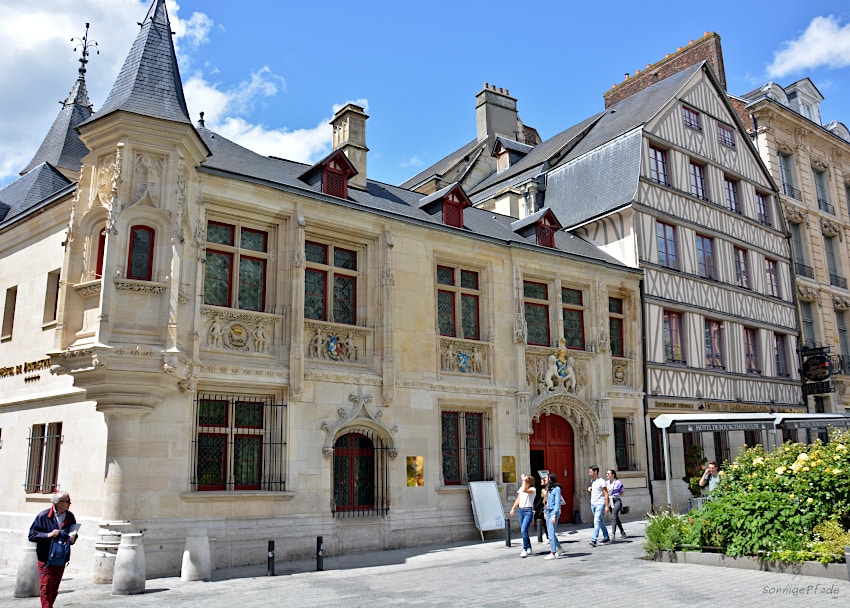
Ossuary Aître Saint Maclou and Saint Maclou Church
One of the smaller churches in Rouen’s old town is Saint Maclou, whose construction began in 1436 and was consecrated in 1521. Behind this church is the ossuary Aître Saint Maclou, which today houses an important art school in Rouen. In 1348, when the plague claimed its victims in Rouen as well, Aître Saint Maclou was a large plague cemetery. This is still remembered by many carvings with „death dance scenes“ – skulls and bones on the half-timbering of the surrounding houses. The inner courtyard of the art school has only in recent years been transformed into a small quiet park with shady trees and is therefore well suited for a break on hot summer days.
In the eastern part of Rouen’s old town stands the large Hotel de Ville (city hall) and next to it the abbey church of St. Ouen. This is not quite as tall, but almost as big as Notre Dame Cathedral. Two such huge churches in hardly 500m distance! The construction of the abbey church St.Ouen began in 1318 as a monastery church of the associated abbey. Significant in this church is especially the large organ from 1890.
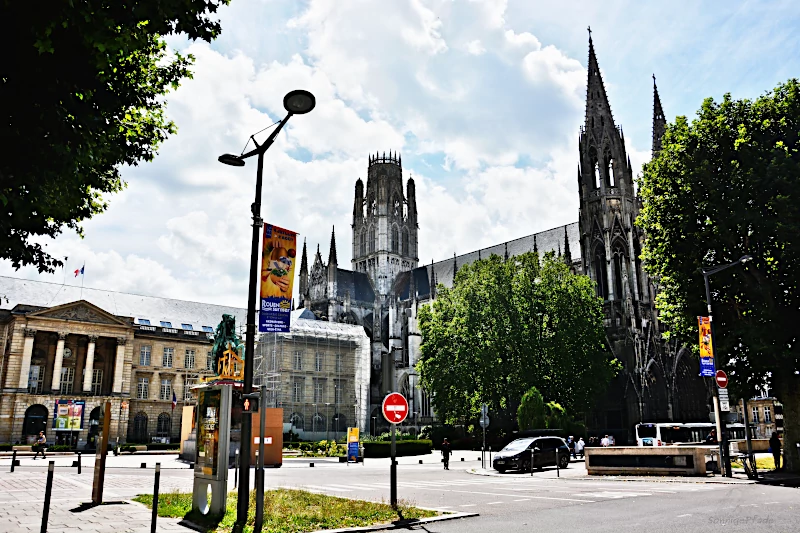
Outside the old town of Rouen
There are many more details to discover in Rouen, especially if you spend a few more days there. For example, on my second visit, I discovered several waterwheels still working on a small stream in the suburbs when I arrived by bicycle; at least one belonged to a small mill museum, the Moulin de la Pannevert.
Art gallery and shopping center on the Seine river banks
A walk along the banks of the Seine is also interesting. The Seine makes huge meandering arcs to the coast and Rouen is located on one of these arcs. East of the city center it is still a relatively narrow river and along the banks are partly abandoned port facilities for river boats. The bridges would not be passable at all, even for seagoing vessels. But about below the Place de Vieux Marcé, the Seine is already quite wide and the old port facilities are now open to the public. On sunny weekend days, many Rouen residents stroll in this area on the banks of the Seine.
In Hangar 107, exhibitions of modern art are offered, at the Rivers Pub below, you can sit in the terrace restaurant and enjoy the view over the Seine or watch the strolling walkers.
Since 2009, there is a large shopping center Docks 76 on the banks of the Seine with many boutiques of French and international brands and entice shopping – guests to thoughtless purchases.
Meanwhile, in Rouen, the huge panoramic images of the artist Yadegar Assisi in a rotunda give impressions of the world with real photos and fictional scenes.
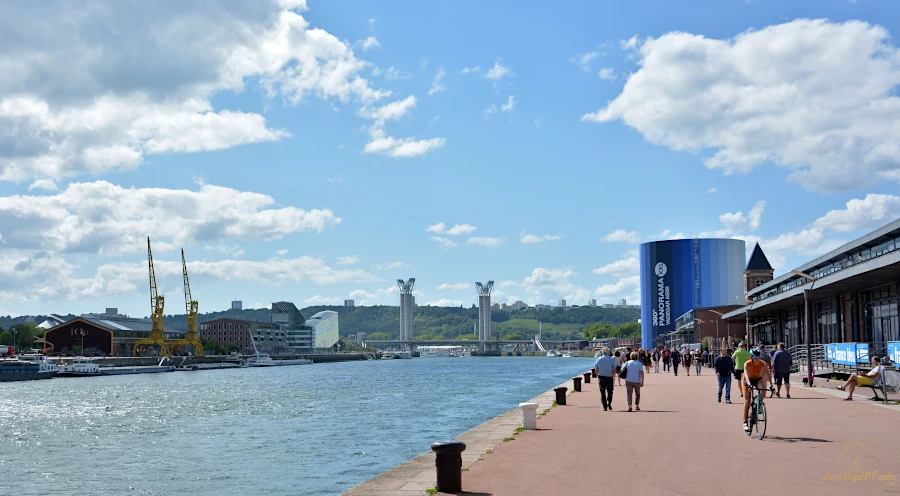
Lift bridge and harbor festival
In 2008, a large road bridge was also built at the western end of the harbor basin near the city. But this one is a technical peculiarity and allows even larger ships to pass. It is a modern lift bridge. The road section on the bridge is raised to a height of 55 meters. The bridge bears the name of the Rouen novelist Gustave Flaubert. The total height of this lift bridge is 86m.
Thanks to this bridge construction, a big harbor festival can be held every 4 to 5 years – the Rouen Armada. Tall ships and other historic vessels reach the old town pier via the Seine and moor there for about 10 days. Many of the ships can be visited during this time. Around the Rouen Armada, a variety of maritime festivities take place along the banks of the Seine.
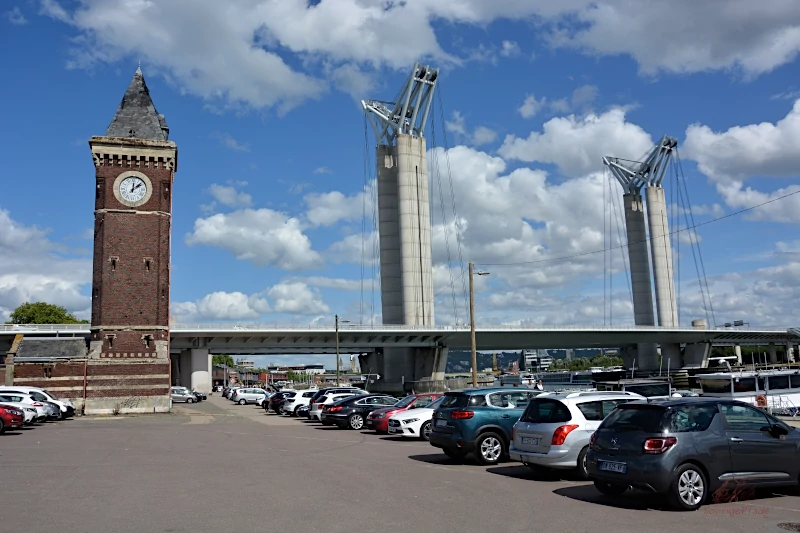
Museums in Rouen
Of course, there are a number of smaller and larger museums in a major city like Rouen that is steeped in history. I have already mentioned the Historial of Joan of Arc in the Bishop’s Palace and also the tower Le Donjon (the keep), where she was imprisoned.
Worth mentioning is the museum of fine arts – Musée des Beaux Arts mainly with paintings from the 15th century to the present.
If you are more into representational art, you may find just what you are looking for in the Museum of Norman Faience Art. Faience is a form of ceramic or porcelain production, which was and is used for everyday objects as well as for artistic design.
The museum Le Secq des Tournelles is a museum of forging art. Forged tools and locks from different periods are kept and displayed here.
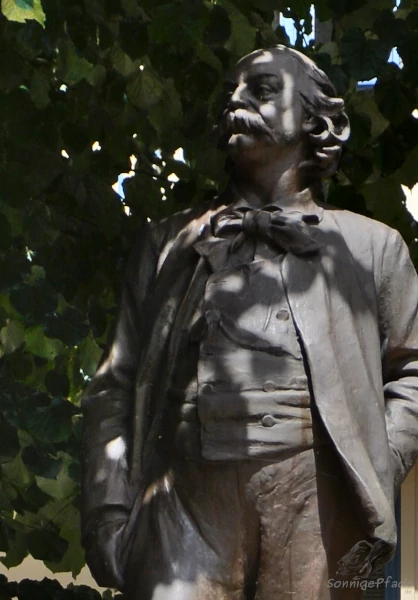
As briefly mentioned, the French novelist Gustave Flaubert was a child of the city of Rouen. One of Flaubert’s most famous works is the novel Madame Bouvery*, a classic of French literature. Flaubert’s father was a doctor and director at the Municipal Hospital, and his official residence bordered directly on the hospital grounds. Therefore, in the house where Flaubert was born, a museum was established both for the novelist Gustave Flaubert and for medical history.
Travel tips for Rouen
How to get there
Best airport opportunities for your arrival in France is Paris. There you will find all services with train or rental car*.
The easiest way to get to Rouen is by train via Paris. Already in 1843 the railroad line Paris – Rouen was built. Today, Rouen is integrated into the French TGV express train network, which runs to LeHavre, Paris and Lyon, among other destinations. The main station Gare de Rouen-Rive-Droite is an Art Nouveau building from 1928.
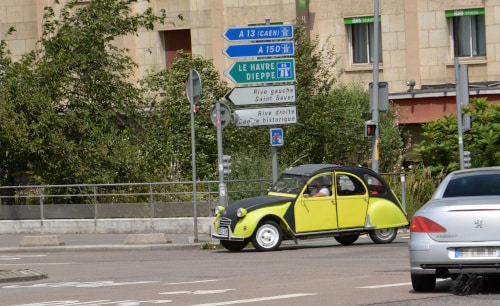
Within Rouen, there is a light rail system that runs under the center for several kilometers.
It is also easy to reach the city of Rouen via the trunk road network by car, motor home* or rental car* across northern France. This can be done via the toll freeways or more slowly and with more impressions of the countryside via national roads and smaller connecting roads. The Seine – bridges in Rouen represent important connections in east – west direction.
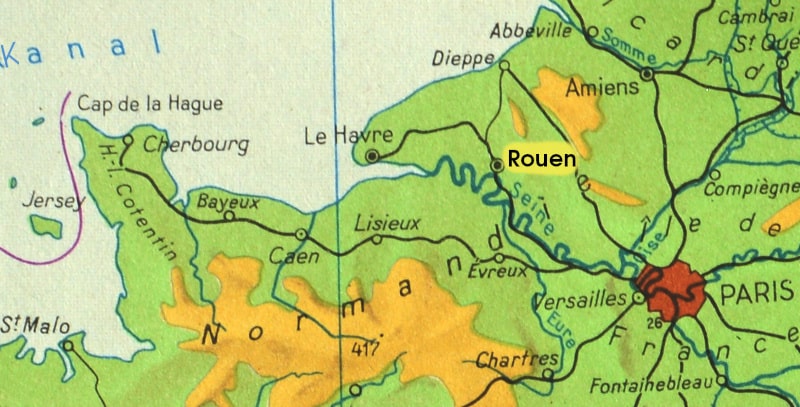
Rouen Weather
If Reims, which is much further inland, has a maritime climate, then even more so does the coastal city of Rouen. Even the tides are noticeable on the Seine river up to Rouen! This means, of course, that you have to be prepared for faster weather changes and possibly rain showers. However, I have always been lucky (in June and September) and had sunny weather in Rouen, only occasionally dampened by passing clouds. Recommended travel time is therefore from May to September, but it is important to be prepared for stronger fluctuations and in any case to have warmer and rainproof clothing in your luggage.
Weather forecast Rouen in Normandy today and the next seven days
Accommodation in Rouen – hotels and apartments
Hotel in the old town of Rouen
A small inexpensive hotel in the historic old town of Rouen is Le vieux carre* in a typical Norman half-timbered house. It’s far from anonymous like many hotels elsewhere: in the courtyard as well as in the common living room, guests can meet and share their experiences and visiting tips. A tasty breakfast is offered every morning in the hotel. In addition to double rooms, there is also a family room. Pets are allowed in the house.
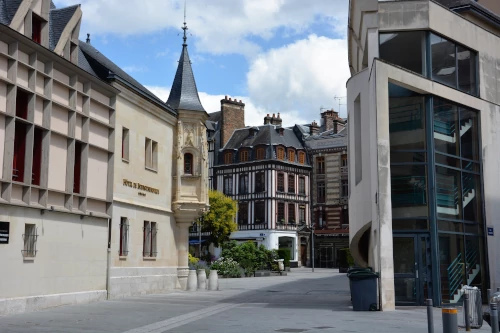
Already mentioned in the previous post is the Hotel de Bourgtheroulde* – a luxurious hotel with spa and wellness – temple in one of the historic buildings of Rouen. The old town is just outside the door. The spa and wellness facilities with indoor pool as well as the restaurant L’Aumale can of course be used with hotel booking as well as by guests without overnight stay. Hotel de Bourgtheroulde has mainly double rooms with extension possibilities for families. Some rooms are prepared for guests with mobility impairments and wheelchair users. Use of the spa and wellness facilities is largely included in the hotel’s overnight rate, but additional charges apply for massages. Pets are allowed at Hotel de Bourgtheroulde. Paid parking is available nearby, including handicapped parking and parking areas with charging stations for e-cars.
Vacation – Apartments
If you prefer a vacation apartment, you will find plenty of them in Rouen.
If you want a dream of luxury in a historic building in the old town of Rouen, then choose the L’Autel – Jaccuzi – Centre d’historique*: Your bed is in a stone vault under pillars, you can make yourself comfortable in the jaccuzi or sauna, or sizzle something tasty in the kitchen. Two guests can sleep in the bedroom of this apartment, and two more on a sofa bed if needed. It is about 500m walk to the cathedral of Rouen.
Also in the old town of Rouen you will find the Bel appartement dans le centre historique*. In this vacation apartment, up to four guests can enjoy relaxing nights in two separate bedrooms. The famous clock Gros Horloge of Rouen is about 300m away, the church Jean d’Arc only about 200m. You can relax with your friends around the billiard table in the living area.
Rouen budget – Accommodation
For visitors with a limited budget, there is an ibis budget Hotel Centre Rive Gauche* just outside the city center. It is about 2.5km from the ibis budget hotel to Notre Dame Cathedral in the old town. The hotel offers simple two-bed rooms, some of which can be expanded to three-guest occupancy with a pull-out bed. Pets are allowed. There is an elevator in the building, some rooms are handicapped accessible. Ample parking is available for a fee in the parking garage, some of which is handicapped accessible.
Rouen has a youth hostel (Auberge de Jeunesse)*, an old dye works, though located just outside to the northeast in an idyllic stream valley. There are private rooms for two to four guests with shared bathrooms as well as dorm beds for budget-conscious single travelers. A youth hostel ID is required for this booking.
On your way to Rouen in Normandy? Invite friends!
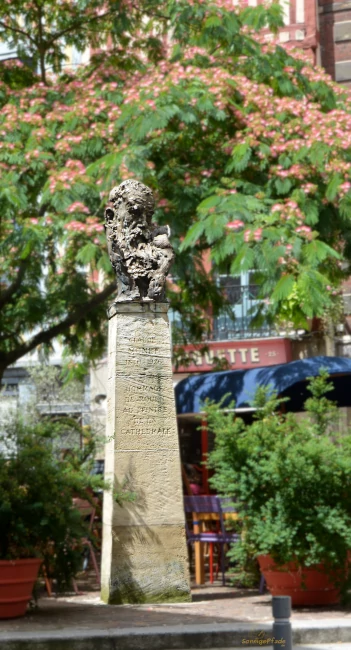
Want to take your friends to Normandy, then send them the link to the post via your social media channels!
At a final summary here a little Rouen FAQ:
The city of Rouen is located in the north of France on the Seine River, about 80km west of the mouth of the Seine River into the English Channel. Rouen is the capital of the Normandy region.
Normandy is a region in the north of France, north of Paris, on the coast of the English Channel.
rowa where the R almost starts with a ch- and is voiceless and also the w is only very flat. Listen to
Yes, definitely! Rouen has a very beautiful old town with narrow streets between half-timbered houses. The cathedral with its mighty façade, the bell towers and the narrow but very high crossing tower is worth a visit in itself. In the old town of Rouen, you can stroll along very historic paths. And on the Seine, the harbor promenade is a new tourist attraction, with a panorama of the photo – artist Yadegar Assisi.
Rouen has a very colorful and varied offer for visitors. It is worth staying for two or three nights in a vacation apartment. History lovers will love the stroll through the old town with numerous half-timbered houses and admire the cathedral and clock tower. Interesting to exciting are the sites of the trial of Jean ‘dArc – the museum in the bishop’s palace or the “Donjon” Joan of Arc – tower with the dungeon, which you can experience in the “escape – game”. Literature lovers will visit the museum of Gustav Flaubert as admirers of blacksmith art will visit the museum Le Secq des Tournelles. Also a walk along the harbor promenade at the Seine is worthwhile – for shopping – fans as for panorama – visitors in an Assisi – Rotunda…
Rouen has settlement traces already since the Neolithic Age 6tsd. years before Christ! Also during the Roman period the city was already inhabited by a Celtic tribe – the Romans called the settlement Rotomagus. In the 4th century Rouen became a bishop’s seat. With such a long history, unfortunately, it is no longer possible to give an exact date of foundation.
The construction of Rouen Cathedral began in 1180 – already in succession to an older building. The cathedral was completed around 1235.
The most famous building of Rouen is the gothic cathedral. Its facade was painted by the painter Claude Monet more than 30 times in different light moods. In Rouen on the market square in 1431 Jean ‘dArc was burned at the stake. Every four to five years the “Armada”, a meeting of tall ships, takes place at the Seine port. Among poultry farmers, the Rouen duck is also famous. This is prepared with the “Sauce Rouenaise” to the “duck in Rouen style” (Canard à la rouennaise).
During World War 2, Rouen was occupied by the Germans from the summer of 1940 to the summer of 1944. During this time Rouen was heavily bombed several times by the Allied air forces. Targets were mainly the Seine – bridges and the freight station.
Note on * advertising links
Some links in the post are marked with * and link to online – stores or agencies. If you buy something there, the sunny trails blog gets a small commission to cover the technical expenses. For you nothing will be more expensive, because the commission is already taken into account in the pricing.

